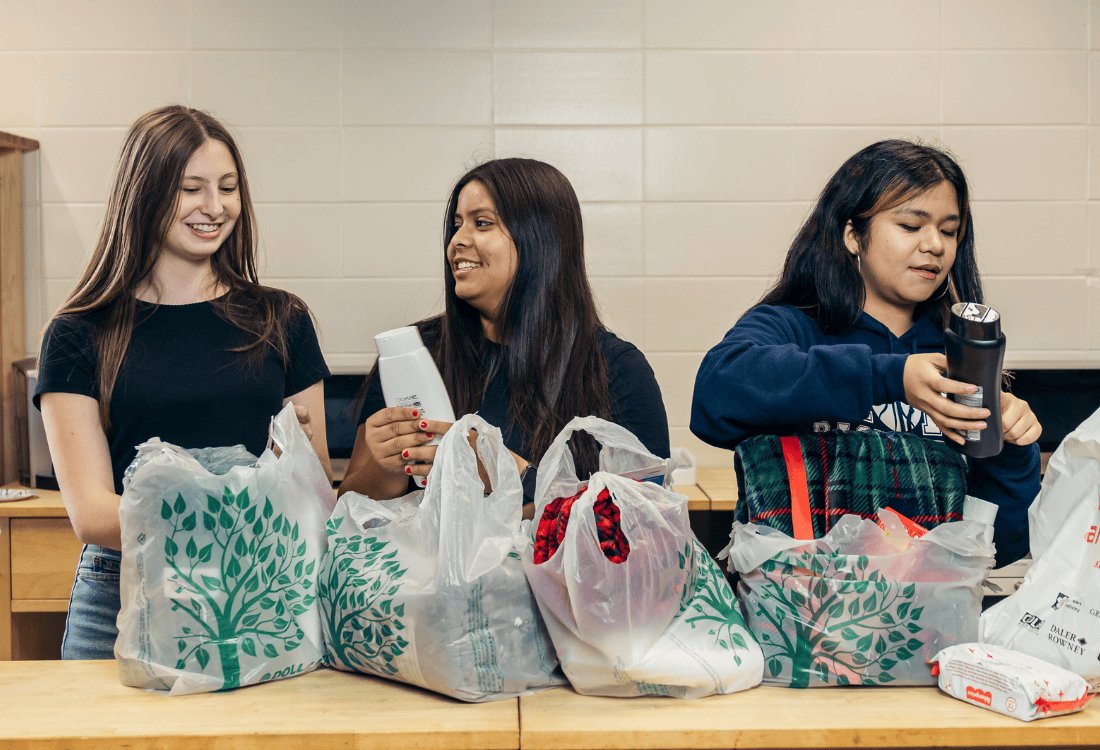
Last year at CHA’s Association Meeting, I was delighted to be able to talk through the Board’s vision for CHA.
In that presentation, I articulated that, like any good vision, its four components – that students are rooted, known, engaged, and inspired – are not only areas in which we do well but are also areas in which we can continue to grow. And none more so than the fourth component: inspiring kids to make a difference. This area is a challenging one. Here’s why.
Struggle 1
Belief is Easier than Action
Have you ever had a conversation with your kids about picking up their stuff in the TV room, met with vigorous agreement and oaths to never do it again – only to find the same mess in the TV room the next day? James doesn’t hold back any punches in this familiar passage:
“But be doers of the word, and not hearers only, deceiving yourselves. For if anyone is a hearer of the word and not a doer, he is like a man who looks intently at his natural face in a mirror. For he looks at himself and goes away and at once forgets what he was like.” (James 1:22-24)
It’s easy to point the finger at our kids, but what about us? Have you ever heard a great sermon about hospitality and then committed to inviting your neighbors over – and then never invited your neighbors over? We are masters at hearing truth and then completely failing to apply it to our lives. It’s a tall order.
The same struggle is, quite naturally, a part of education. As we work through course content, students and teachers and parents alike easily fall prey to learning the right things and saying the right things but altogether forgetting that the point is what they can do with it. Learning in the faith should lead to action. It should be driven by vocational purpose rooted in love and service.
Question: How do we inspire our kids to link faith and learning to action?
Struggle 2
We Want to Protect Our Kids, not Train Them
I recently listened to a lecture by NYU social psychologist Jonathan Haigt in which he asks a group of parents about the age at which they were allowed to venture off alone into their neighborhood growing up. The universal answer was 6 to 8. Then he asks what age they allow their own kids to do the same – despite the fact that their neighborhoods are very likely much safer. The answer was 10-12. The net result of this approach, applied more broadly of course, according to Haigt, is a generation unprepared for the world. Our instinct as parents is always to keep our kids safer. To provide the easier road. But the ironic reality is that over-sheltering our kids stunts their preparedness for (read: ability, ultimately, to live safely in) the real world. Kids that are always told to be safe have a hard time living lives that have an impact.
Again, this same struggle is a part of education. It’s much easier and safer for kids to memorize the list and restate it for the quiz. It’s much harder and riskier for both student and teacher to work out the real life implications together and discover why it’s important. Students would have to do some things they haven’t before. Discussions that might be uncomfortable. Collaboration that might be with people they don’t like. Presentations that make them feel nervous. It would involve risk and failure and trial and error. But that’s where real learning happens.
Question: How do we provide experiences for our kids that train them to courageously navigate risk and have a bold impact?
Struggle 3
Typical Education is Typically Passive, not Active, and Rewards-Based, not Purpose-Based
Traditional education methods in the context of school are, for the most part, set up for passive learning. Sit. Listen. Remember. Regurgitate. Repeat. This passive learning (open up the head, pour the info in) is typically oriented toward short-term, rewards-based motivation. Getting an “A.” A gold star. A checkbox. It works for a lot of kids (It certainly worked for me for a while!), but it doesn’t necessarily produce adults who are disciples of Jesus who dynamically love and serve others through their vocations.
Interestingly, it’s not how Jesus’ disciples learned. They learned through questions. They learned through discussion about the why. They learned through experience. (I challenge you to explore Jesus as a master and his disciples as learners. His pedagogy is fascinating.)
CHA is not here to get kids into certain colleges by working the system and playing the game. We are here to equip and inspire kids to be lifetime followers of Jesus who love and serve others. Getting into a great school is a frequent benefit of following Jesus with everything. But that is not the point. Approaching teaching and learning as passive and rewards-based is not all bad, but only doing so stunts our kids’ ability to make a deep and meaningful impact.
Question: How do we enable our kids to be deeply involved in their learning and to understand its purpose for their lives as followers who love and serve?
Below is a roadmap we’ve been discussing at length at CHA over the last couple years. These are steps in the right direction and where we hope to go – with parents as partners – in the coming two to three school years. More awaits, but the following are projects in our immediate future.
Solution 1
Dig into Discussion about Real Issues
Our curriculum is already excellent, but excellence is dynamic, not static. We need to work on how we dynamically prepare our graduates to engage with the real, current, and even controversial issues of our ever-changing world. Our five-year curriculum review cycle starts next year, and we very intentionally chose two departments for Year One: Bible and Social Studies. These departments will be undergoing discussions in 2024-25 about how to bring vital social and cultural issues to the forefront. Are our students (when age appropriate, of course!) able to understand and respectfully discuss current debates about gender and sexuality from a biblical perspective? Do they have an informed perspective on current issues like Israel-Palestine or AI? Are they able to love their neighbor well even if their neighbor has a very different cultural heritage? Are they able to respectfully engage in and learn from discussions with those who disagree? As we evaluate our curricula and pedagogy, year by year, we want these crucial skills to be a focus at CHA. Doing so will help our students to understand that what they learn in the humanities isn’t only about grades but is also about action, change, and standing up for what is right and honoring to God.
Solution 2
Provide Opportunities for Leadership
Schools can be incredible laboratories for leadership development; we just have to see them that way and push students to take ownership. A former student of mine in Taiwan wished our school had more journalism opportunities. She and I worked together to start a club, build a staff, and publish a school newspaper for three years. She ended up at Northwestern studying journalism. Leadership takes practice. Run for Student Council. Edit the yearbook. Start a club. Lead a trip. Be a TA. Captain a team. We so want to make leadership a priority at CHA that next year Terri Acres’ full time role will be as our new Student Life and Leadership Coordinator, working with Student Council, Guidance, clubs, and athletics to facilitate opportunities for leadership growth in our Middle and especially Upper School students. As a small school, we can be leadership development trendsetters for students interested and gifted in leadership – a place for students to take personal risks and grow from them into the next generation of Christian leaders.
Solution 3
Always Link Learning to The Point
This fall our faculty completed a workshop on the value of our Expected Student Outcomes (ESOs) in the classroom. In our continued unit planning, teachers must always be able to link course content with one of our recently-developed ESOs for students. Why are we having a discussion about the dark side of freedom in the context of A Tale of Two Cities? We want you to be able to speak the truth so you can have an impact. Why are we practicing the clarinet until our jaw hurts? We want you to excel in your gifts so you can have an impact. Why are we balancing chemical equations with a partner? We want you to think critically and collaboratively so you can have an impact. We celebrate when students ask why; we encourage you as parents to ask them the same question. Keeping your grades up is important, but they can never be more consequential than the learning they reflect and require. Join us in encouraging our students toward purpose-based learning.
Solution 4
Facilitate an Authentic Audience
When you wrote an essay for school, who read it? A hundred bucks says it was probably only your teacher. And then it went in the garbage. The reality is, we do our best work when there is an audience. For most of us, that’s what our jobs are. We argue a case in front of a jury. We provide a report to a committee. We make music for an audience. We market events for potential attendees.
Imagine a school that emulated that real-life motivation:
Seventh grade short stories published in the library and on Amazon.
A mock supreme court case viewed by half the high school and live streamed on youtube.
A math competition for Lower School students and run by an Upper School math class.
Our teachers are working on building more and more authentic assessments for our students, emphasizing the purpose of what they are learning. Next year we also plan to begin a multi-year project to develop grade-level exhibitions in which parents are invited to attend a learning exhibition hosted by students. We also just finished our first go at a Senior Capstone course for our seniors, spending the year focusing on how they might use what they have learned in Upper School to have a vocational impact. We will keep developing this important program for seniors. We are working to grow into a school that is exemplary in its ability to make learning active.
Solution 5
Actually Serve
Finally, nothing equips and inspires lifetime followers of Jesus who love and serve others more than actually taking a full week of school to do just that. Each year CHA has been building its GO! Week programs. This past year, CHA students served 16 ministries from Chicago to the Dominican Republic, and the experiences were life transforming. GO! Week is about putting faith into action. It’s about taking a risk to love and serve others. It’s about active, purpose-based learning.
Please pray with us that these aims and programs flourish in the coming few years. Pray for our faculty and staff that they would have ideas that inspire. Pray that the Holy Spirit would work in the hearts of our students, prompting them to grow and develop and be inspired toward whatever vocational role God has for them. Pray that God would use our graduates to make a real difference in Jesus’ name in the world around them. And pray that God would grow our influence – that more and more parents would enroll their kids here, seeing CHA as a workshop for God’s workmanship (Eph 2:10), created in Christ Jesus to do the good work God has prepared in advance for them to do!
—JT
























